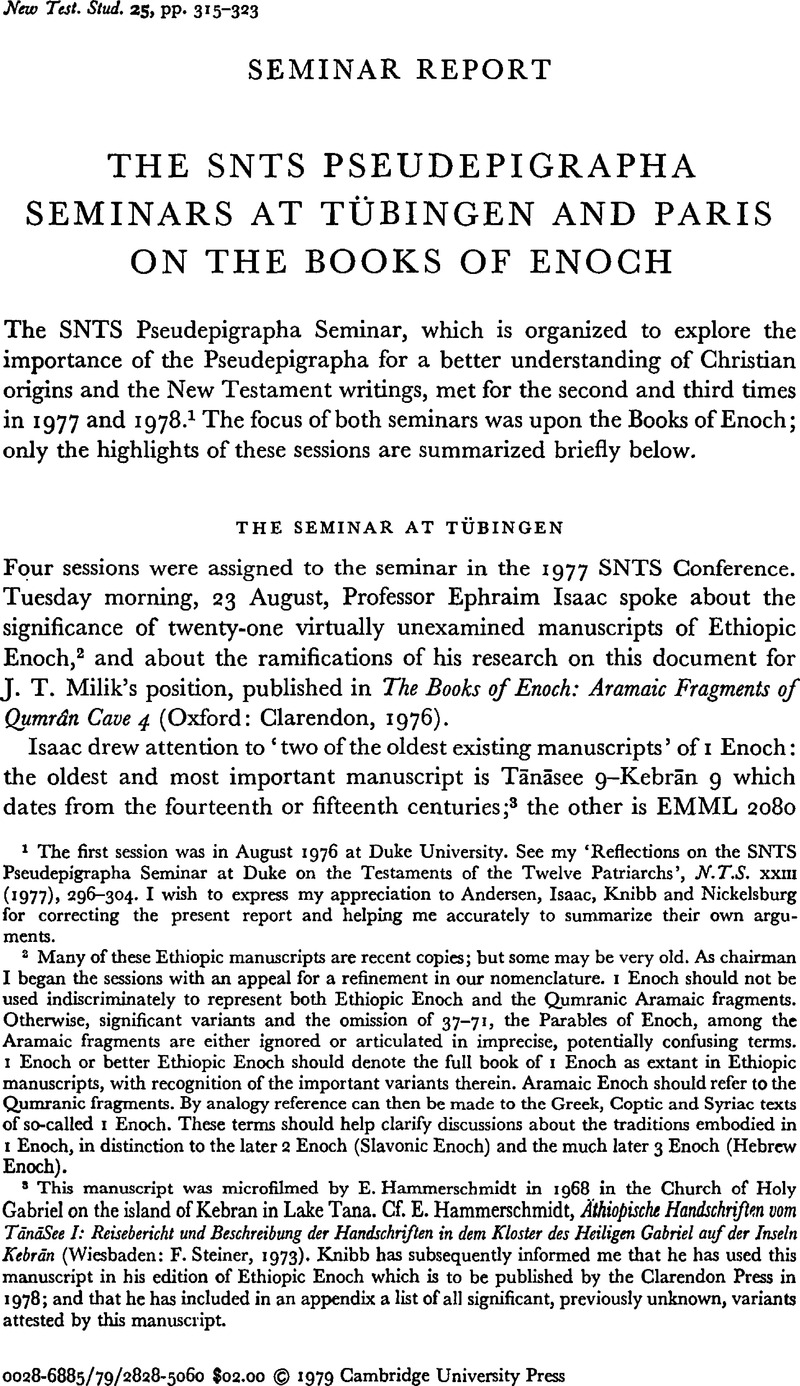Published online by Cambridge University Press: 05 February 2009

1 The first session was in August 1976 at Duke University. See my ‘Reflections on the SNTS Pseudepigrapha Seminar at Duke on the Testaments of the Twelve Patriarchs’, N.T.S. xxiii 1977), 296–304. I wish to express my appreciation to Andersen, Isaac, Knibb and Nickelsburg for correcting the present report and helping me accurately to summarize their own arguments.
2 Many of these Ethiopic manuscripts are recent copies; but some may be very old. As chairman I began the sessions with an appeal for a refinement in our nomenclature. I Enoch should not be used indiscriminately to represent both Ethiopic Enoch and the Qumranic Aramaic fragments. Otherwise, significant variants and the omission of 37–71, the Parables of Enoch, among the Aramaic fragments are either ignored or articulated in imprecise, potentially confusing terms. i Enoch or better Ethiopic Enoch should denote the full book of I Enoch as extant in Ethiopic manuscripts, with recognition of the important variants therein. Aramaic Enoch should refer to the Qumranic fragments. By analogy reference can then be made to the Greek, Coptic and Syriac texts of so-called I Enoch. These terms should help clarify discussions about the traditions embodied in I Enoch, in distinction to the later 2 Enoch (Slavonic Enoch) and the much later 3 Enoch (Hebrew Enoch).
3 This manuscript was microfilmed by E. Hammerschmidt in 1968 in the Church of Holy Gabriel on the island of Kebran in Lake Tana. Cf. Hammerschmidt, E., Äthiopische Handschriften vom TānāSee I: Reisebericht und Beschreibung der Handschriften in dem Kloster des Heiligen Gabriel auf der Inseln Kebrān (Wiesbaden: F. Steiner, 1973)Google Scholar. Knibb has subsequently informed me that he has used this manuscript in his edition of Ethiopic Enoch which is to be published by the Clarendon Press in 1978; and that he has included in an appendix a list of all significant, previously unknown, variants attested by this manuscript.
4 EMML represents the Ethiopian Manuscript Microfilm Library which is catalogued by Macomber, W. M. and published by the Monastic Manuscript Microfilm Library of St John's Abbey and University in Collegeville, Minnesota.Google Scholar
5 J. H. Charlesworth, E. Isaac, V. MacDermot, Chr. Burchard, Th. Korteweg, H.-W. Kuhn, R. Kearns, I. A. Moir, A. Böhlig, J. P. Heil, L. Hartman, F. I. Andersen, A. B. Kolenkow, B. Schaller, G. Nickelsburg, H. P. Kingdon, G. W. MacRae and S. Agourides.
6 These and other observations are now found in Nickelsburg's review of Milik's Books of Enoch in C.B.Q. 40. (1978), 411–18.Google Scholar
7 Andersen and I wish to express our deep appreciation to the Library of the Academy of Sciences of the USSR in Leningrad for supplying microfilms of these manuscripts. These microfilms and glossy photographs are preserved in the International Center for the Study of Christian Origins at Duke University. Our attention was drawn to these manuscripts by Meshchersky, N. A.; see his publications listed in my The Pseudepigrapha and Modern Research (SCS 7) (Missoula, Montana: Scholars, 1976), pp. 103–6.Google Scholar
8 Le livre des secrets d'Hénoch: Texte slave et traduction française (Textes publiés par l'institut d'études slaves 4) (Paris: Institut d'études slaves, 1952).Google Scholar
9 Andersen knows of the arguments along similar lines by Pines, S. in ‘Eschatology and the Concept of Time in the Slavonic Book of Enoch ’, Types of Redemption: Contributions to the Theme of the Study-Conference Held at Jerusalem, 14th to 19th 07 1968, eds. Werblowsk, R. J. Z. and Bleeker, C. J. (SupplNumen 18) (Leiden: Brill, 1970), pp. 72–87 (esp. see p. 72, note 1).Google Scholar
10 Qumran Texts (Moscow, 1971), p. 297 [in Russian].Google Scholar
11 In attendance were J. H. Charlesworth, G. Nickelsburg, M. A. Knibb, D. R. Catchpole, M. de Jonge, L. Hartman, H. Lichtenberger, R. Maddox, I. A. Moir, P. W. van der Horst, F. van Menxel, N. Walter, A. R. C. Leaney, G. L. Davenport, E. Isaac, S. Benètreau, and A.-M. Denis.
12 Other scholars, not necessarily specialists on i Enoch, are preparing or have recently published translations of this document: E. Hammershaimb into Danish, Rau into German, S. Agourides into modern Greek, A. Caquot into French, T. Muraoka into Japanese, F. Carriente into Spanish. See my ‘Translating the Apocrypha and Pseudepigrapha: A Report of International Projects’, Bulletin of the International Organization for Septuagint and Cognate Studies 10 (1977), 11–21Google Scholar; ‘New Developments in the Study of the Ecrits Intertestamentaires’, B.I.O.S.C.S. 11 (1978), 14–18Google Scholar; and ‘A History of Pseudepigrapha Research: The Re-Emerging Importance of the Pseudepigrapha’, to be published in Aufstieg und Niedergang der Römischen Welt.
13 Black, M. (ed.), Apocalypsis Henochi Graece (PVTG 3) (Leiden: Brill, 1970).Google Scholar
14 ‘St Luke's Gospel and the Last Chapters of, i Enoch’, N.T.S. 13 (1966), 1–13.Google Scholar
15 ‘In conclusion it is around the year A.D. 270 or shortly afterwards that I would place the composition of the Book of Parables.’ Milik, Books of Enoch, p. 96.
16 ‘The “Parables” of Enoch (i En 37–71) and the “Son of Man”’, Exp. T. 88 (1976), 5–8.Google Scholar
17 ‘The Parables of Enoch – Origin and Date’, Exp. T. 89 (1978), 118 f.Google Scholar
18 Translation by Charles, R. H., The Book of Enoch (Oxford: Clarendon, 1912), p. 110.Google Scholar
19 ‘Thus the date of the Parables could not have been earlier than 94 B.C. or later than 64 B.C.’ Charles, The Book of Enoch, p. liv.